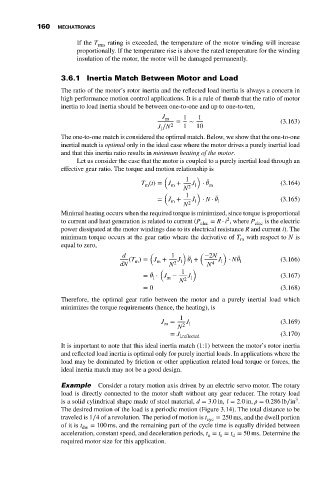Page 174 - Mechatronics with Experiments
P. 174
160 MECHATRONICS
If the T rms rating is exceeded, the temperature of the motor winding will increase
proportionally. If the temperature rise is above the rated temperature for the winding
insulation of the motor, the motor will be damaged permanently.
3.6.1 Inertia Match Between Motor and Load
The ratio of the motor’s rotor inertia and the reflected load inertia is always a concern in
high performance motion control applications. It is a rule of thumb that the ratio of motor
inertia to load inertia should be between one-to-one and up to one-to-ten,
J m 1 1
= ∼ (3.163)
J ∕N 2 1 10
l
The one-to-one match is considered the optimal match. Below, we show that the one-to-one
inertial match is optimal only in the ideal case where the motor drives a purely inertial load
and that this inertia ratio results in minimum heating of the motor.
Let us consider the case that the motor is coupled to a purely inertial load through an
effective gear ratio. The torque and motion relationship is
( 1 )
T (t) = J + J l ⋅ ̈ m (3.164)
m
m
N 2
( 1 )
= J + J l ⋅ N ⋅ ̈ l (3.165)
m
N 2
Minimal heating occurs when the required torque is minimized, since torque is proportional
2
to current and heat generation is related to current (P elec = R ⋅ i , where P elec is the electric
power dissipated at the motor windings due to its electrical resistance R and current i). The
minimum torque occurs at the gear ratio where the derivative of T with respect to N is
m
equal to zero,
d ( 1 ) ̈ ( −2N ) ̈
(T ) = J + J l + J l ⋅ N l (3.166)
l
m
m
dN N 2 N 4
( 1 )
̈
= ⋅ J − J (3.167)
l m 2 l
N
= 0 (3.168)
Therefore, the optimal gear ratio between the motor and a purely inertial load which
minimizes the torque requirements (hence, the heating), is
1
J = J l (3.169)
m
N 2
= J l,reflected (3.170)
It is important to note that this ideal inertia match (1:1) between the motor’s rotor inertia
and reflected load inertia is optimal only for purely inertial loads. In applications where the
load may be dominated by friction or other application related load torque or forces, the
ideal inertia match may not be a good design.
Example Consider a rotary motion axis driven by an electric servo motor. The rotary
load is directly connected to the motor shaft without any gear reducer. The rotary load
3
is a solid cylindrical shape made of steel material, d = 3.0in, l = 2.0in, = 0.286 lb∕in .
The desired motion of the load is a periodic motion (Figure 3.14). The total distance to be
traveled is 1∕4 of a revolution. The period of motion is t cyc = 250 ms, and the dwell portion
of it is t dw = 100 ms, and the remaining part of the cycle time is equally divided between
acceleration, constant speed, and deceleration periods, t = t = t = 50 ms. Determine the
d
a
r
required motor size for this application.

